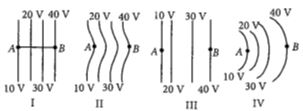The diagrams below show regions of equipotentials.A positive charge is moved from $A$ to $B$ in each diagram.

The diagrams below show regions of equipotentials.A positive charge is moved from $A$ to $B$ in each diagram.

- [NEET 2017]
- A
In all the four cases the work done is the same.
- B
Minimum work is required to move $q$ in figure $(I).$
- C
Maximum work is required to move $q$ in figure $(II).$
- D
Maximum work is required to move $q$ in figure $(III).$
Similar Questions
$S_1$ and $S_2$ are two equipotential surfaces on which the potentials are not equal. Which of the statement is incorrect ?
$S_1$ and $S_2$ are two equipotential surfaces on which the potentials are not equal. Which of the statement is incorrect ?
Thepoints resembling equal potentials are
Thepoints resembling equal potentials are
Electric field is always ...... to the equipotential surface at every point. (Fill in the gap)
Electric field is always ...... to the equipotential surface at every point. (Fill in the gap)
A point charge $+Q$ is placed just outside an imaginary hemispherical surface of radius $R$ as shown in the figure. Which of the following statements is/are correct?
(IMAGE)
$[A]$ The electric flux passing through the curved surface of the hemisphere is $-\frac{\mathrm{Q}}{2 \varepsilon_0}\left(1-\frac{1}{\sqrt{2}}\right)$
$[B]$ Total flux through the curved and the flat surfaces is $\frac{Q}{\varepsilon_0}$
$[C]$ The component of the electric field normal to the flat surface is constant over the surface
$[D]$ The circumference of the flat surface is an equipotential
A point charge $+Q$ is placed just outside an imaginary hemispherical surface of radius $R$ as shown in the figure. Which of the following statements is/are correct?
(IMAGE)
$[A]$ The electric flux passing through the curved surface of the hemisphere is $-\frac{\mathrm{Q}}{2 \varepsilon_0}\left(1-\frac{1}{\sqrt{2}}\right)$
$[B]$ Total flux through the curved and the flat surfaces is $\frac{Q}{\varepsilon_0}$
$[C]$ The component of the electric field normal to the flat surface is constant over the surface
$[D]$ The circumference of the flat surface is an equipotential
- [IIT 2017]
Figure shows a set of equipotential surfaces. The magnitude and direction of electric field that exists in the region is .........
Figure shows a set of equipotential surfaces. The magnitude and direction of electric field that exists in the region is .........
